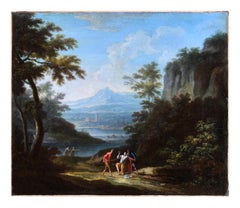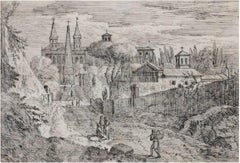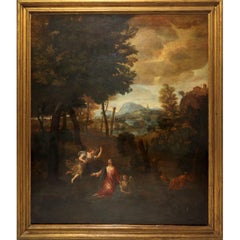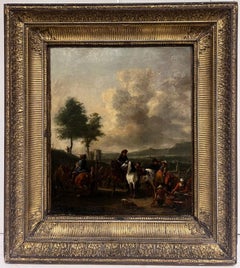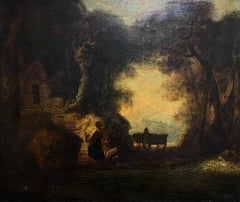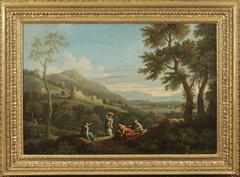Jan Frans van Bloemen (Orizzonte) Art
Flemish, 1662-1749
Jan Frans van Bloemen (baptized 12 May 1662 - buried 13 June 1749) was a Flemish landscape painter mainly active in Rome. Here he was able to establish himself as the leading painter of views (vedute) of the Roman countryside depicted in the aesthetic of the classical landscape tradition. Van Bloemen predominantly painted classical landscapes, taking his inspiration from the Roman Campagna. His landscapes, with their recession through a series of planes, soft, warm lightning and classical and religious subject matter, drew on the examples of artists such as Claude Lorrain and Gaspard Dughet. His paintings are exquisitely imbued with that "difficult-to-define pastoral ambience" which helped to make him such a great painter in the eyes of his contemporaries. The technique and subjects of the work of Jan Frans van Bloemen are also related to painters such as Jan Asselijn, Thomas Wyck, Willem Romeyn and Willem Schellinks. His painted vedute fall into the category of the vedute that combine reality with imaginary elements. His landscapes have an Arcadian lushness, with mountains, streams, distant hamlets, and small inhabitants painted with imprecise pittura di tocco ('painting of touch') using small dotting and spirited brush-strokes. Unlike van Wittel, van Bloemen did not generally depict views of areas distant from Rome such as the Tiber valley or the Alban hills. His subjects were limited to views in the immediate vicinity of Rome, an outline of which was typically visible in his compositions. Van Bloemen was in particular known for his 'estate views' representing the estates of the nobility in the Roman Campagna. His views aim to associate the modern estate view with the classical arcadian landscape. Rather than offering the wide panoramic views, distant horizon and atmospheric effects associated with topographical landscapes, van Bloemen's estate views emphasize minute observation of reality and a limited viewpoint. The estates are thus made to appear as immutable features of the local landscape. He worked together with other painters who painted the figures in his landscapes such as Carlo Maratti, Placido Costanzi and Pompeo Batoni. However, he only relied on such collaboration with figure painters in the last decades of his life when he produced his most ambitious classicising compositions. Even then he only relied on these figure specialists for the most prominent figures in the foreground while he took care of the minor characters. In fact, van Bloemen was an accomplished staffage painter and he was very skilled at quickly learning to imitate the style of his collaborators. As a result, many of the figures in his paintings that are attributed to prestigious contemporaries were actually by his own hand. His landscape drawings, which often depict imaginary ruins, have been confused with those of his brother Pieter, who is better known for his drawings of figures and animals. Jan Frans van Bloemen also made pen drawings of buildings in and around Rome.to
4
3
8
7
2
1
Two Arcadic Landscapes - J.F. Van Bloemen (follower of) - Oil on Canvas
By Jan Frans van Bloemen (Orizzonte)
Located in Roma, IT
Two Arcadic Landscapes are a couple of original oil paintings by a follower of the Flemish artist, Jan Frans Van Bloemen (1662-1749).
These old master's original paintings represen...
Category
Early 18th Century Old Masters Jan Frans van Bloemen (Orizzonte) Art
Materials
Oil
Pair of Roman Landscapes - by J.F. Van Bloemen - 18th Century
By Jan Frans van Bloemen (Orizzonte)
Located in Roma, IT
Beautiful couple of Roman Landscape by J. F. Van Bloemen, in very good conditions and with later wooden frames.
Bibliography and Exhibitions:
Old Master Exhibition, H.Terry-Engell, ...
Category
Early 18th Century Jan Frans van Bloemen (Orizzonte) Art
Materials
Oil, Canvas
Wooden Landscape with Shepherds, Fountain and Flock - by Jan Frans van Bloemen
By Jan Frans van Bloemen (Orizzonte)
Located in Roma, IT
Bibliography:
A.Busiri Vici, Jan Frans Van Bloemen Orizzonte e l’origine del paesaggio romano settecentesco, Ugo Bozzi Editore, Roma 1974, n.41
This artwork is shipped from Italy. U...
Category
18th Century Old Masters Jan Frans van Bloemen (Orizzonte) Art
Materials
Canvas, Oil
17th century etching black and white figurative landscape trees buildings
By Jan Frans van Bloemen (Orizzonte)
Located in Milwaukee, WI
"Conversation Outside Castle" is an original etching by Jan Frans van Bloemen. It depicts a number of figures just outside the majestic walls of a castle. These groups of figures are engaged in their own conversations.
9" x 6 3/4" art
21 5/8" x 19 3/8" frame
Jan Frans van Bloemen (baptized 12 May 1662 - buried 13 June 1749) was a Flemish landscape painter mainly active in Rome. Here he was able to establish himself as the leading painter of views (vedute) of the Roman countryside depicted in the aesthetic of the classical landscape tradition.
Van Bloemen predominantly painted classical landscapes, taking his inspiration from the Roman Campagna. His landscapes, with their recession through a series of planes, soft, warm lightning and classical and religious subject matter, drew on the examples of artists such as Claude Lorrain and Gaspard Dughet. His paintings are exquisitely imbued with that "difficult-to-define pastoral ambience" which helped to make him such a great painter in the eyes of his contemporaries. The technique and subjects of the work of Jan Frans van Bloemen are also related to painters such as Jan Asselijn...
Category
18th Century Old Masters Jan Frans van Bloemen (Orizzonte) Art
Materials
Etching
17th century etching black and white figurative landscape cityscape buildings
By Jan Frans van Bloemen (Orizzonte)
Located in Milwaukee, WI
"Figures Outside the Monastery" is an original etching by Jan Frans van Bloemen. It depicts people on the path to a church.
7" x 10 1/4" art
19 1/4" x 22 5/8" frame
Jan Frans van Bloemen (baptized 12 May 1662 - buried 13 June 1749) was a Flemish landscape painter mainly active in Rome. Here he was able to establish himself as the leading painter of views (vedute) of the Roman countryside depicted in the aesthetic of the classical landscape tradition.
Van Bloemen predominantly painted classical landscapes, taking his inspiration from the Roman Campagna. His landscapes, with their recession through a series of planes, soft, warm lightning and classical and religious subject matter, drew on the examples of artists such as Claude Lorrain and Gaspard Dughet. His paintings are exquisitely imbued with that "difficult-to-define pastoral ambience" which helped to make him such a great painter in the eyes of his contemporaries. The technique and subjects of the work of Jan Frans van Bloemen are also related to painters such as Jan Asselijn, Thomas Wyck...
Category
18th Century Old Masters Jan Frans van Bloemen (Orizzonte) Art
Materials
Etching
Jan Frans van Bloemen Knew as L'Orizzonte Biblical Painting Scene Oil on Canvas
By Jan Frans van Bloemen (Orizzonte)
Located in Roma, IT
Jan Frans van Bloemen The Horizon -
H 100x83 cm, framed 113x98
Van Bloemen, the Flemish painter known as "L'Orizzonte," trained first in his native country and, after a stay in Franc...
Category
17th Century Jan Frans van Bloemen (Orizzonte) Art
Materials
Oil
17th century etching black and white figurative landscape trees statues scene
By Jan Frans van Bloemen (Orizzonte)
Located in Milwaukee, WI
"Mother & Child Near Statues" is an original etching by Jan Frans van Bloemen. It depicts two figures, a mother and child pair, next two two classical statues. There are other figures in this park-like environment.
9 1/4" x 6 3/4" art
21 5/8" x 19 3/8" frame
Jan Frans van Bloemen (baptized 12 May 1662 - buried 13 June 1749) was a Flemish landscape painter mainly active in Rome. Here he was able to establish himself as the leading painter of views (vedute) of the Roman countryside depicted in the aesthetic of the classical landscape tradition.
Van Bloemen predominantly painted classical landscapes, taking his inspiration from the Roman Campagna. His landscapes, with their recession through a series of planes, soft, warm lightning and classical and religious subject matter, drew on the examples of artists such as Claude Lorrain and Gaspard Dughet. His paintings are exquisitely imbued with that "difficult-to-define pastoral ambience" which helped to make him such a great painter in the eyes of his contemporaries. The technique and subjects of the work of Jan Frans van Bloemen are also related to painters such as Jan Asselijn...
Category
18th Century Old Masters Jan Frans van Bloemen (Orizzonte) Art
Materials
Etching
17th century etching black and white figurative landscape obelisk buildings
By Jan Frans van Bloemen (Orizzonte)
Located in Milwaukee, WI
"Figures at the Obelisk" is an original etching by Jan Frans van Bloemen. It depicts two people conversing in front of a monument. Behind them, an expansive landscape sprawls.
9 1/4" x 6 3/4" art
21 3/4" x 19 3/8" frame
Jan Frans van Bloemen (baptized 12 May 1662 - buried 13 June 1749) was a Flemish landscape painter mainly active in Rome. Here he was able to establish himself as the leading painter of views (vedute) of the Roman countryside depicted in the aesthetic of the classical landscape tradition.
Van Bloemen predominantly painted classical landscapes, taking his inspiration from the Roman Campagna. His landscapes, with their recession through a series of planes, soft, warm lightning and classical and religious subject matter, drew on the examples of artists such as Claude Lorrain and Gaspard Dughet. His paintings are exquisitely imbued with that "difficult-to-define pastoral ambience" which helped to make him such a great painter in the eyes of his contemporaries. The technique and subjects of the work of Jan Frans van Bloemen are also related to painters such as Jan Asselijn, Thomas Wyck...
Category
18th Century Old Masters Jan Frans van Bloemen (Orizzonte) Art
Materials
Etching
Related Items
Fine 17th Century Dutch Old Master Oil Military Encampment Figures on Horseback
By Philips Wouwerman
Located in Cirencester, Gloucestershire
The Military Encampment
Dutch School, 17th century
circle of Philips Wouwermans (Dutch 1619-1668)
oil painting on canvas, in 18th century gilt frame
canvas measures: 19.5 x 17 inches...
Category
17th Century Old Masters Jan Frans van Bloemen (Orizzonte) Art
Materials
Oil, Canvas
$5,410
H 27 in W 24 in D 2 in
Large 18th Century British Old Master Oil Painting Figures at Dusk in Woodland
Located in Cirencester, Gloucestershire
The Close of Day
English artist, second half 18th century
circle of Thomas Gainsborough (British 1727-1788)
oil on canvas, unframed
canvas: 24.5 x 29 inches
provenance: private colle...
Category
18th Century Old Masters Jan Frans van Bloemen (Orizzonte) Art
Materials
Oil, Canvas
$3,013
H 24.5 in W 29 in
18th Century French Old Master Oil Painting Ancient Port Harbor Shipping Marine
Located in Cirencester, Gloucestershire
Harbor Scene
Circle of Claude Joseph Vernet (French, 1714-1789)
oil painting on canvas, framed in antique gilt frame
framed: 20.5 x 25.5
canvas: 19 x 23.5 inches
condition: very good...
Category
18th Century Old Masters Jan Frans van Bloemen (Orizzonte) Art
Materials
Oil, Canvas
$4,040
H 20.5 in W 25.5 in
Figures in Winter Dutch Snow Landscape Large 19th Century Oil on Canvas Painting
Located in Cirencester, Gloucestershire
The Winter Landscape
Dutch School, 19th century
oil painting on canvas, framed
framed: 22 x 28 inches
canvas: 16.5 x 23 inches
provenance: private collection, UK
condition: very goo...
Category
19th Century Old Masters Jan Frans van Bloemen (Orizzonte) Art
Materials
Oil, Canvas
Antique English Grand Tour Old Master Oil Figures Classical Arcadian Landscape
Located in Cirencester, Gloucestershire
Classical Landscape
oil on canvas, framed
framed: 29 x 37 inches
canvas : 19 x 27 inches
Provenance: private collection, UK
Condition: the frame is exceptionally fragile and vulnerab...
Category
Early 19th Century Old Masters Jan Frans van Bloemen (Orizzonte) Art
Materials
Oil, Canvas
Antique Dutch Oil Painting Figures at Sunset by Coastal Estuary with Buildings
Located in Cirencester, Gloucestershire
A River Landscape With A Figure On A Donkey
1800's Dutch School
oil painting on canvas, framed
framed: 21 x 27 inches
canvas: 18 x 24 inches
provenance: private collection, England
...
Category
Early 19th Century Old Masters Jan Frans van Bloemen (Orizzonte) Art
Materials
Oil, Canvas
Fishing at Dawn Old Trading Port with Many Figures Large Oil Painting
Located in Cirencester, Gloucestershire
Fishing at Dawn
English artist after an earlier work (see inscription verso)
signed oil painting on canvas, framed
inscribed verso
framed: 23 x 31 inches
canvas: 18 x 26inches
proven...
Category
Late 20th Century Old Masters Jan Frans van Bloemen (Orizzonte) Art
Materials
Canvas, Oil
$2,465
H 23 in W 31 in
"Local Residents, " Oil painting
By Judd Mercer
Located in Denver, CO
Judd Mercer's (US based) "Local Residents," is an original, handmade oil painting that depicts a green grassy pasture where a herd of black cows graze.
About the Artist:
Judd Mercer is a watercolor painter based in Denver, Colorado. After attending art school for industrial design, Judd pursued a career in digital design and user experience and is co-owner of Elevated Third, a Denver-based digital agency.
After committing to writing and illustrating a full-length fantasy novel in his spare time, Judd began watercolor painting around 2014, studying with teachers such as Alvaro Castagnet, Joseph Zbukvic and Herman Pekel...
Category
2010s Realist Jan Frans van Bloemen (Orizzonte) Art
Materials
Oil, Canvas
Fine 1800's French Oil Figures by Monastic Ruins Stream Bucolic Landscape
Located in Cirencester, Gloucestershire
Monastic Ruins by a Stream
French School, early 1800's
oil on canvas, framed
Framed 15 x 19 inches
Canvas : 12.5 x 16 inches
Provenance: private collection, France
Condition: very go...
Category
Early 19th Century Old Masters Jan Frans van Bloemen (Orizzonte) Art
Materials
Oil
$2,047
H 15 in W 19 in
Mid 17th Century British Old Master Oil Painting Portrait of Man in Flemish City
Located in Cirencester, Gloucestershire
Portrait of Thomas Collard (rector of Withycombe, Somerset 1670-1691)
the city depicted in the distance is thought to be Antwerp.
the portrait historically has been thought to be fr...
Category
Mid-17th Century Old Masters Jan Frans van Bloemen (Orizzonte) Art
Materials
Oil, Canvas
Suite of 12 Views of Italy
By Franz Weirotter
Located in New York, NY
Franz Weirotter (1730-1771), Suite of 12 Views of Italy, etchings, 1759 [most signed in the plate by Weirotter]. Reference: Nagel 5. 10 printed in pairs on one sheet; one on a small...
Category
1750s Old Masters Jan Frans van Bloemen (Orizzonte) Art
Materials
Etching
Huge 1800's English Oil Painting Man with Horses Resting Panoramic Country View
By Thomas Barker of Bath
Located in Cirencester, Gloucestershire
Pausing for a Rest
English School, circa 1800
the painting is very close to the works of Thomas Barker of Bath (English 1769-1847)
oil on canvas, framed
framed: 29 x 39 inches
canvas...
Category
Early 19th Century Old Masters Jan Frans van Bloemen (Orizzonte) Art
Materials
Oil, Canvas
$3,342
H 29 in W 39 in D 1 in
Previously Available Items
Landscape with Arcadian Figures
By Jan Frans van Bloemen (Orizzonte)
Located in New York, NY
Provenance:
Purchased in Belgium, 1950s (as by Poussin)
Private collection, 1950s to present
Orizzonte is best known for his Italian countryside scenes, but his early training...
Category
17th Century Old Masters Jan Frans van Bloemen (Orizzonte) Art
Materials
Acrylic Polymer, Canvas, Oil
Landscape with Arcadian Figures
By Jan Frans van Bloemen (Orizzonte)
Located in New York, NY
Jan Frans van Bloemen, called Orizzonte.
Orizzonte is best known for his Italian countryside scenes, but his early training was in Flemish landscape painting. While still fairly ...
Category
18th Century and Earlier Jan Frans van Bloemen (Orizzonte) Art
Materials
Oil, Canvas
Jan Frans Van Bloemen (orizzonte) art for sale on 1stDibs.
Find a wide variety of authentic Jan Frans van Bloemen (Orizzonte) art available for sale on 1stDibs. You can also browse by medium to find art by Jan Frans van Bloemen (Orizzonte) in etching, oil paint, paint and more. Much of the original work by this artist or collective was created during the 18th century and is mostly associated with the Old Masters style. Not every interior allows for large Jan Frans van Bloemen (Orizzonte) art, so small editions measuring 20 inches across are available. Customers who are interested in this artist might also find the work of Anthonie Waterloo, George Morland, and Sir Godfrey Kneller. Jan Frans van Bloemen (Orizzonte) art prices can differ depending upon medium, time period and other attributes. On 1stDibs, the price for these items starts at $1,700 and tops out at $54,589, while the average work can sell for $1,700.
